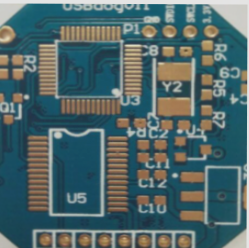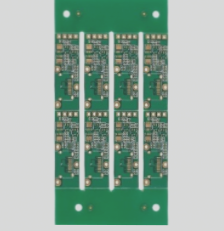1. The various stages of the PCB assembly process encompass the application of solder paste to the circuit board, component selection and placement, soldering, as well as inspection and testing.
2. Each of these steps is crucial and must be closely monitored to guarantee the production of the highest quality products.
3. The PCB assembly process outlined below presumes the use of surface mount components, as nearly all modern PCB assembly relies on surface mount technology.
4. Solder paste: Prior to placing components on the board, solder paste must be applied to the designated areas on the board, typically the component pads.
5. This application is accomplished using a solder screen.
6. Solder paste consists of a mixture of tiny tin particles and flux, which can be deposited in one step, resembling certain printing techniques.

1. Using a solder screen, place it directly on the circuit board and align it correctly. A runner moves through the screen, forcing a small amount of solder paste through the openings onto the circuit board. The solder screen is created from the printed circuit board file, featuring holes that correspond to the tin pads, ensuring solder is deposited solely on those pads.
2. The quantity of solder deposits must be carefully controlled to guarantee that the joints produced contain the correct amount of solder.
3. Selection and placement: During this phase of the assembly process, the board with solder paste proceeds to the selection and placement stage. Here, a machine equipped with reels of components selects items from these reels or other dispensers and positions them accurately on the circuit board.
4. The adhesion of the solder paste keeps the components securely in place on the circuit board, provided that the board remains stable.
5. In some assembly processes, the pick-and-place machine may apply small dots of adhesive to secure the components on the board. However, this is generally only performed when the board undergoes wave soldering. A downside to this method is that repairs become more challenging due to the presence of glue, although some adhesives are formulated to break down during the soldering process.
6. The position and component data necessary for programming the pick-and-place machine is derived from the PCB design information. This significantly simplifies the programming of the pick-and-place operation.
7. Soldering: Once the components are added to the circuit board, the next stage involves the soldering machine. While some boards may pass through a wave soldering machine, this method is less commonly used for surface mount components today. If wave soldering is employed, no solder paste is added since the solder is supplied directly by the wave soldering machine. Reflow soldering technology is now more prevalent than wave soldering.
8. Inspection: After the circuit board has undergone the soldering process, it is typically inspected. For surface mount boards with 100 or more components, manual inspection is impractical. Instead, automatic optical inspection offers a more viable solution. Current machines can inspect boards for defective joints, misplaced components, and, in some instances, incorrect components.
9. Testing: Electronic products must undergo testing before they leave the factory. There are several testing methods available. More information on testing strategies and techniques can be found in the “Test and Measurement” section of this website.
10. Feedback: To ensure the manufacturing process runs smoothly, it is essential to monitor output by analyzing any faults detected. The optimal time for this is during the optical inspection stage, which typically follows the soldering process. This allows for quick identification and correction of defects before a significant number of boards with the same issues are produced.
11. Summary: This overview has streamlined the PCB assembly process used to manufacture loaded printed circuit boards. PCB assembly and production processes are typically optimized to achieve very low defect levels, thereby ensuring the highest quality products. Given the extensive number of components and solder joints in modern products, along with the stringent quality requirements, the effective operation of this process is crucial to the success of the final product.
2. Each of these steps is crucial and must be closely monitored to guarantee the production of the highest quality products.
3. The PCB assembly process outlined below presumes the use of surface mount components, as nearly all modern PCB assembly relies on surface mount technology.
4. Solder paste: Prior to placing components on the board, solder paste must be applied to the designated areas on the board, typically the component pads.
5. This application is accomplished using a solder screen.
6. Solder paste consists of a mixture of tiny tin particles and flux, which can be deposited in one step, resembling certain printing techniques.

1. Using a solder screen, place it directly on the circuit board and align it correctly. A runner moves through the screen, forcing a small amount of solder paste through the openings onto the circuit board. The solder screen is created from the printed circuit board file, featuring holes that correspond to the tin pads, ensuring solder is deposited solely on those pads.
2. The quantity of solder deposits must be carefully controlled to guarantee that the joints produced contain the correct amount of solder.
3. Selection and placement: During this phase of the assembly process, the board with solder paste proceeds to the selection and placement stage. Here, a machine equipped with reels of components selects items from these reels or other dispensers and positions them accurately on the circuit board.
4. The adhesion of the solder paste keeps the components securely in place on the circuit board, provided that the board remains stable.
5. In some assembly processes, the pick-and-place machine may apply small dots of adhesive to secure the components on the board. However, this is generally only performed when the board undergoes wave soldering. A downside to this method is that repairs become more challenging due to the presence of glue, although some adhesives are formulated to break down during the soldering process.
6. The position and component data necessary for programming the pick-and-place machine is derived from the PCB design information. This significantly simplifies the programming of the pick-and-place operation.
7. Soldering: Once the components are added to the circuit board, the next stage involves the soldering machine. While some boards may pass through a wave soldering machine, this method is less commonly used for surface mount components today. If wave soldering is employed, no solder paste is added since the solder is supplied directly by the wave soldering machine. Reflow soldering technology is now more prevalent than wave soldering.
8. Inspection: After the circuit board has undergone the soldering process, it is typically inspected. For surface mount boards with 100 or more components, manual inspection is impractical. Instead, automatic optical inspection offers a more viable solution. Current machines can inspect boards for defective joints, misplaced components, and, in some instances, incorrect components.
9. Testing: Electronic products must undergo testing before they leave the factory. There are several testing methods available. More information on testing strategies and techniques can be found in the “Test and Measurement” section of this website.
10. Feedback: To ensure the manufacturing process runs smoothly, it is essential to monitor output by analyzing any faults detected. The optimal time for this is during the optical inspection stage, which typically follows the soldering process. This allows for quick identification and correction of defects before a significant number of boards with the same issues are produced.
11. Summary: This overview has streamlined the PCB assembly process used to manufacture loaded printed circuit boards. PCB assembly and production processes are typically optimized to achieve very low defect levels, thereby ensuring the highest quality products. Given the extensive number of components and solder joints in modern products, along with the stringent quality requirements, the effective operation of this process is crucial to the success of the final product.




